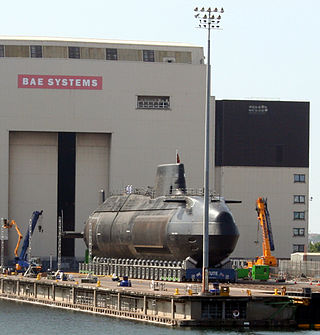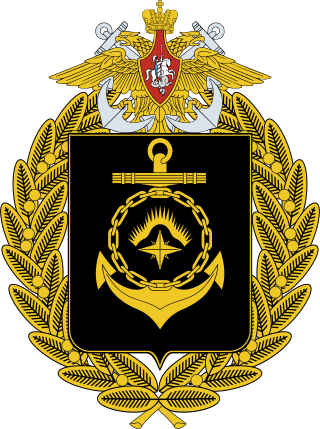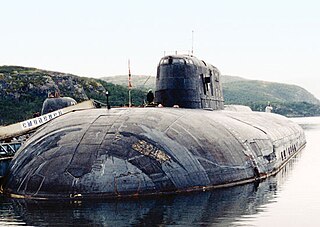
The Ohio class of nuclear-powered submarines includes the United States Navy's 14 ballistic missile submarines (SSBNs) and its four cruise missile submarines (SSGNs). Each displacing 18,750 tons submerged, the Ohio-class boats are the largest submarines ever built for the U.S. Navy. They are also the third-largest submarines ever built, behind the Russian Navy's Soviet era 48,000-ton Typhoon class, the last of which was retired in 2023, and 24,000-ton Borei class. Capable of carrying 24 Trident II missiles apiece, the Ohio class are equipped with just as many missiles as, if not more than, either the Borei class (16) or the deactivated Typhoon class (20).

K-141 Kursk was an Oscar II-class nuclear-powered cruise missile submarine of the Russian Navy. On 12 August 2000, K-141 Kursk was lost when it sank in the Barents Sea, killing all 118 personnel on board.

The Oscar class, Soviet designations Project 949 Granit and Project 949A Antey, are a series of nuclear-powered cruise missile submarines designed in the Soviet Union for the Soviet Navy. First built in the 1970s, six remain in service with the Russian Navy. Two other vessels were slated to be modernized since at least 2017 as Project 949AM, to extend their service life and increase combat capabilities but it is unclear whether work continues as of 2023.

A cruise missile submarine is a submarine that carries and launches cruise missiles as its primary armament. Missiles greatly enhance a warship's ability to attack surface combatants and strike land targets; although torpedoes are a more discreet option for submerged submarines, missiles give a much longer stand-off range, shorter time to impact the target, as well as the ability to engage multiple targets on different headings at the same time. Many cruise missile submarines retain the capability to deploy nuclear warheads on their missiles, but they are considered distinct from ballistic missile submarines due to the substantial differences between the two weapons systems' flight characteristics; cruise missiles fly aerodynamically using flight surfaces like wings or fins, while a ballistic missile uses its engine power alone as it may exit the atmosphere.
K-27 was the only nuclear submarine of the Soviet Navy's Project 645. It was constructed by placing a pair of experimental VT-1 nuclear reactors that used a liquid-metal coolant into the modified hull of a Project 627A (November-class) vessel. A unique NATO reporting name was not assigned.

A nuclear submarine is a submarine powered by a nuclear reactor, but not necessarily nuclear-armed. In the US classification, nuclear-powered submarines are designated as SSxN, where the SS denotes submarine, x=G means that the submarine is equipped with guided missiles, x=B means that the submarine is equipped with ballistic missiles and the N means that the submarine is nuclear-powered. SSN refers to nuclear-powered attack submarines, which do not carry missiles.

The Akula class, Soviet designation Project 971 Shchuka-B is a series of fourth generation nuclear-powered attack submarines (SSNs) first deployed by the Soviet Navy in 1986. There are four sub-classes or flights of Shchuka-B, consisting of the original seven Project 971 boats, commissioned between 1984 and 1990; six Project 971Is, commissioned between 1991 and 2009; one Project 971U, commissioned in 1995; and one Project 971M, commissioned in 2001. The Russians call all of the submarines Shchuka-B, regardless of modifications.

The Northern Fleet is the fleet of the Russian Navy in the Arctic.

An SSN is a nuclear-powered general-purpose attack submarine. SSN is the US Navy hull classification symbol for such vessels; the SS denotes a submarine and the N denotes nuclear power. The designation SSN is used for interoperability throughout NATO under STANAG 1166, though navies use other terms.
The K-442 Chelyabinsk is an Oscar II Class SSGN of the Russian Navy.

Igor Dmitriyevich Spassky was a Soviet and Russian scientist, engineer and entrepreneur, General Designer of nearly 200 Soviet and Russian nuclear submarines, and the head of the Central Design Bureau for Marine Engineering Rubin.

JSC PO Sevmash is a Russian joint-stock company (JSC) under the vertically-integrated United Shipbuilding Corporation. The shipbuilding operations of Sevmash is in the port city of Severodvinsk on the White Sea in the Russian Federation.
The decommissioning of Russian nuclear-powered vessels is an issue of major concern to the United States and to Scandinavian countries near Russia. From 1950 to 2003, the Soviet Union and its major successor state, Russia, constructed the largest nuclear-powered navy in the world, with more ships than all other navies combined: 248 submarines, four Kirov-class battlecruisers, and a missile test ship, as well as nine icebreakers. Many were or are powered by two reactors each, bringing the total to 468 reactors.

K-525 Arkhangelsk was an Oscar I-class nuclear-powered cruise missile submarine of the Soviet Navy, and later the Russian Navy. She was the first of the two Oscar I vessels constructed, the other being K-206. A further 11 submarines of an improved class, Project 949A (Antey), were subsequently constructed.

K-266 Orel is a Project 949AM nuclear-powered cruise missile submarine (SSGN). She is one of three Oscar II submarines still serving in the Russian Northern Fleet, all assigned to the 11th Submarine Division, berthed at Guba Bolshaya Lopatka, on the Kola Peninsula northwest of Severomorsk.
The K-119 Voronezh is an Oscar-class submarine in the Russian Navy.

The K-150 Tomsk is an Oscar-class submarine in the Russian Navy.

The K-410 Smolensk is an Oscar-class submarine in the Russian Navy.
The K-132 Irkutsk is an Oscar-class submarine in the Russian Navy.













